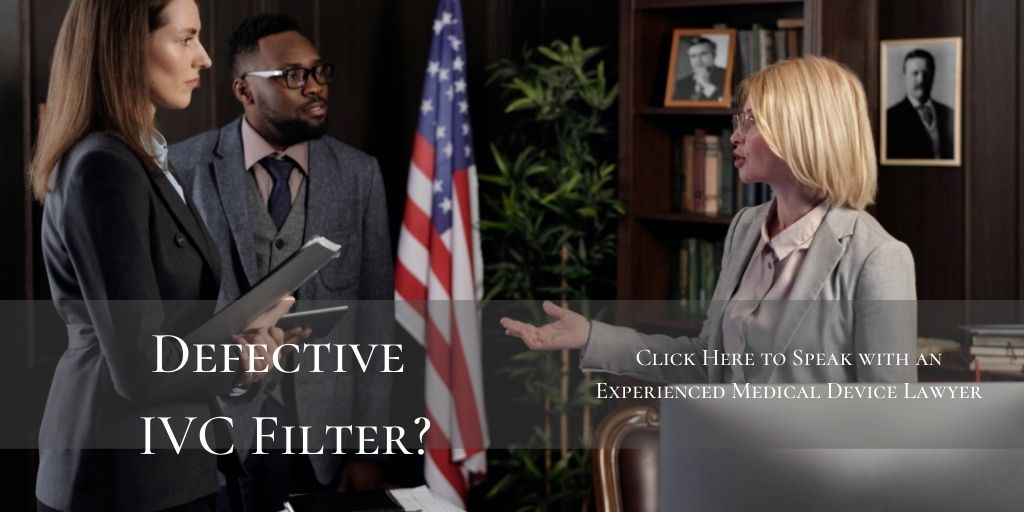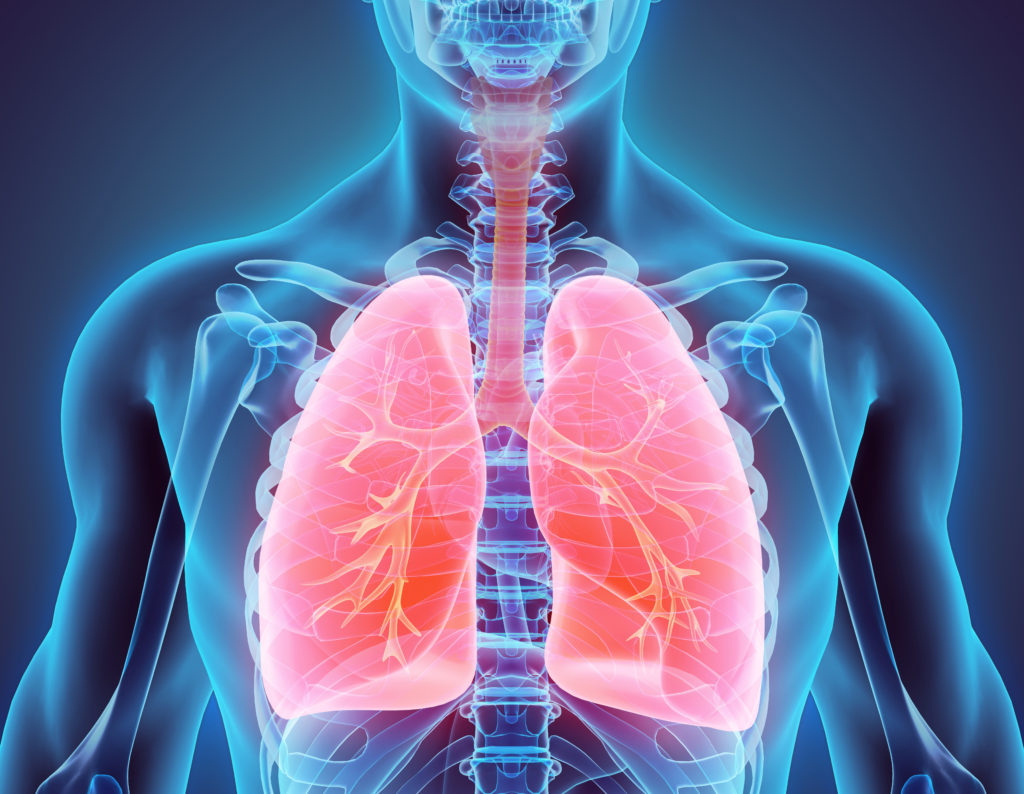Potential Risks and Downfalls
Patients who suffer from pulmonary embolisms often are prone to clotting complications which leads to lifelong use of medications such as warfarin or direct oral anticoagulants (blood thinners). Inferior Vena Cava (IVC) Filters have been shown to be used in preventing pulmonary embolisms when blood thinning therapy has failed or cannot be used due to complications. The Food and Drug Administration (FDA) has deemed IVC filters to have relatively low morbidity and mortality associated with placement and removal. However, complications have been seen that we will discuss below.
What is a Pulmonary Embolism?
A pulmonary embolism occurs when a blood clot is formed and breaks loose which travels to the lungs through the bloodstream. This can cause chest pain and shortness of breath which are the main signs and symptoms of the disorder. When a blood clot travels to the lungs, it blocks blood flow in the arteries which can cause impaired lung function and eventual lung failure if untreated.
Pulmonary embolisms are responsible for about 100,000 to 200,000 deaths in the United States each year. Unfortunately, many cases are undiagnosed and it is important to understand how you can prevent clotting risks associated with them.
Complications of IVC Filters
An IVC filter consists of a filter being placed inside a large vein called the vena cava; which carries blood from your lower body to your heart and lungs. This is a surgical process consisting of using a camera-guided probe through a vein in your neck.
In general, there are three complications that can arise during IVC filter placement. The first complication can occur during the access to your vein. There may be unforeseen clots in the access vein which would indicate use of an ultrasound to guide the probe through the vein. The second complication has to do with the placement of the IVC filter. If the filter is placed in a location that doesn’t properly filter the blood, another filter must be placed in the correct location. The third complication arises when the filter does not expand correctly which can lead to poor filtration or dislodging. This means that the filter can migrate to a different part of the vein and need removal.
Let’s say the IVC filter is correctly placed and the surgical procedure is a success. There are additional risks that can occur afterwards as well. Another clotting condition called a Deep Vein Thrombosis (DVT) can occur which is a clot that develops in the legs. A study showed that up to 40% of patients can develop a DVT after filter placement. This shows that even with successful placement, there can be risks for additional clotting factors.
There are two different types of filters that can be used based off the severity of risks: temporary or permanent filters. Temporary filters must be removed through another surgical process since they do not contain materials built to last in the body. Permanent filters are indicated for long-term use and are generally not removed unless problems arise. The same risks apply for IVC filter removal as insertion with additional risks which can warrant longer procedure time and non-standard techniques for removal.
There are other complications that were not discussed that can contribute to other risks regarding IVC filter placement and retrieval. Studies do not have strong data with these other potential risks and were not included for that reason. Studies do suggest that there are higher complications relating to temporary filters, however, based on self-reported rates by patients who have received the surgery.
Real World Concerns
Due to the risks associated with IVC filter placement, there have been hundreds of injuries and multiple lawsuits involving this procedure. Many cases involved filter fragments breaking off and traveling to different parts of the lungs or heart. This caused punctures and injuries to the local organs as a foreign sharp object floated through the bloodstream. These cases resulted in ongoing health problems for those effected and lifelong medication use. Many IVC filter companies have recalled their products due to these injuries as it became a public concern. The positive outcomes have been limited with these filters and is a reason they are a last line option for pulmonary embolism prevention.
How to Prevent Blood Clots
Preventing blood clots before any complications of a pulmonary embolism is ideal. This can be done by anyone to reduce your risk of a clotting event such as regular exercise, maintaining a healthy body weight, and quitting smoking for those who smoke. Regular exercise should consist of at least 30-minutes of activity 3-5 times a week. A healthy body weight is measured by someone’s body mass index (BMI) which is calculated based off the height and weight of the person. A healthy BMI ranges from 18.5-24.9 in the general public. There are many online calculators you can search for to calculate your BMI. Smoking cigarettes can increase the thickness of your blood putting you at a higher risk for developing a clot. It is important to know that quitting is the best prevention method for current smokers for developing a clot.
Less common preventative measures that many people may not think of is during long travels. When we are in a seated or laying down position for extended periods of time, our blood does not flow as easily throughout the body. This can lead to blood pooling in the legs creating a clot which can lead to a pulmonary embolism if the clot breaks loose. Best prevention methods for long travels is to stand or walk every hour, drink lots of water, and to not smoke/drink alcohol during travels.
What This Means For You
By now I hope you feel knowledgeable about the many risks associated with IVC filters. It is something that should be avoided if possible when prone to a pulmonary embolism. The preferred method of prevention is through a healthy lifestyle with or without medication management. As discussed, this includes a healthy diet, physical activity, a healthy BMI, and quitting smoking. Medication treatment may require frequent follow-up visits and monitoring but has much more safety information and proven effectiveness.
IVC filters are a last-ditch effort in most people to prevent a pulmonary embolism when medications don’t work or in emergency situations. It is important to understand the signs and symptoms of the disease and what preventative measures you can make to reduce your risk of a blood clot.
Sources Cited (6)
- About Your Inferior Vena Cava (IVC) Filter Placement. Memorial Sloan Kettering Cancer Center. Revised: March 2019. Accessed November 2019. https://www.mskcc.org/cancer-care/patient-education/ivc-filter-placement
- Pai, Menaka; Douketis, James. Prevention of Venous Thromboembolic Disease in Acutely Ill Hospitalized Medical Adults. UpToDate. Hudson, Ohio: Wolters Kluwer Clinical Drug Information, Inc.; 2013; April 15, 2013. Accessed November 2019. https://ntserver1.wsulibs.wsu.edu:2102/contents/prevention-of-venous-thromboembolic-disease-in-acutely-ill-hospitalized-medical-adults?search=prevent%20vte&source=search_result&selectedTitle=1~150&usage_type=default&display_rank=1#H1842903009
- Sentry Inferior Vena Cava Filter. Department of Health & Humans Services. Revised: January 2017. Accessed November 2019. https://www.accessdata.fda.gov/cdrh_docs/pdf16/K162875.pdf
- Tarbox, Abigail K; Swaroop, Mamta. Pulmonary Embolism. International Journal of Critical Illness and Injury Science. 2013; 3(1): 69-72. Accessed November 2019. doi: 10.4103/2229-5151.109427. https://www.ncbi.nlm.nih.gov/pmc/articles/PMC3665123/
- Van Ha, Thuong G. Complications of Inferior Vena Caval Filters. Seminars in Interventional Radiology. 2006; 23(2): 150-155. Accessed November 2019. doi: 10.1055/s-2006-941445. https://www.ncbi.nlm.nih.gov/pmc/articles/PMC3036364/
- Venous Thromboembolism. National Heart, Lung, and Blood Institute. Revised: 2017. Accessed November 2019. https://www.nhlbi.nih.gov/health-topics/venous-thromboembolism


 COVID-19: What you need to know. Coronaviruses are a type of virus; some of which cause disease. A newly identified type of this virus has caused the outbreak of a respiratory illness named COVID-19. Have you or a loved one been impacted by COVID-19? Read further for additional information about this disease and how to move forward from here.
COVID-19: What you need to know. Coronaviruses are a type of virus; some of which cause disease. A newly identified type of this virus has caused the outbreak of a respiratory illness named COVID-19. Have you or a loved one been impacted by COVID-19? Read further for additional information about this disease and how to move forward from here.
